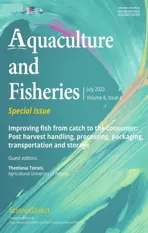Biogenic amines in fresh fish and fishery products and emerging control
2023-10-19AbimannanArulkumarSpirosParamithiotisSadayanParamasivam
Abimannan Arulkumar, Spiros Paramithiotis, Sadayan Paramasivam
a Department of Oceanography and Coastal Area Studies, School of Marine Sciences, Alagappa University, Science Campus, Karaikudi, 630 003, Tamil Nadu, India
b Department of Biotechnology, Achariya Arts and Science College, Affiliated to Pondicherry University, Villianur, Puducherry, 605 110, India
c Department of Food Science and Human Nutrition, Agricultural University of Athens, Iera Odos 75, GR-11855, Athens, Greece
Keywords:Fresh fish Cephalopods Crustaceans Shellfish Histamine
ABSTRACT Occurrence of biogenic amines in fresh fish and fishery products constitute a significant safety concern.Ingestion of histamine is identified as the causative agent of several food poisoning incidences on an annual basis.In addition, cadaverine, putrescine and tyramine have been recognized as potentiators of histamine poisoning.Accumulation of biogenic amines in fresh fish and fishery products has been mainly attributed to growth of bacteria possessing amino acid decarboxylase activity, which is facilitated by lack of hygienic conditions and strict temperature control during their storage.To this end, the effectiveness of traditional and modern approaches to control biogenic amine accumulation has been in the epicenter of intensive study.The aim of the present review article is to update and integrate current knowledge regarding the biogenic amine content of fresh fish and fishery products as well as the capacity of traditional and emerging control strategies.
1.Introduction
Biogenic amines are naturally occurring low molecular weight compounds with aliphatic, aromatic and heterocyclic chemical structures.They are present in a variety of foods and beverages including fish and fishery products, meat and meat products, cheese, wine, vegetables,chocolates and nuts (Li & Lu et al., 2020; Sanchez-Perez et al., 2018;Sivamaruthi et al., 2020; Spizzirri et al., 2019; Swider et al., 2020;Zuljan et al., 2016).They play a major role in cell growth and development, altering stomach pH, brain activity and regulating the blood pressure in living cells.However, their consumption may cause food poisoning and allergic reaction in humans and animals.Among the different biogenic amines (tryptamine, putrascine, cadaverine, histamine, tyramine, spermine, spermidine, histamine is considered as a most important toxin because its accumulation can cause a series of toxic effects similar to common food allergy, such as swelling, rashes, hives,and asthma-like symptoms as well as gastrointestinal symptoms (Maintz& Novak, 2007).Other symptoms of fish poisoning are oral numbness,headache, dizziness, palpitation, rapid and weak pulse (low blood pressure), thirst as well as less specific symptoms such as nausea,vomiting, abdominal cramps and diarrhoea (Gilbert et al., 1980; Taylor et al., 1989).Presence of high levels of biogenic amines in food is mainly due to the activity of bacterial decarboxylases on free amino acids(Chong et al., 2014; Wunderlichova et al., 2012).Biogenic amines cannot be degraded by commonly used food preservation methods such as freezing, cooking, sun drying and smoking (Etkind et al., 1987).
Gram-negative bacteria are the predominant amine-forming bacteria in fish, crustaceans, and cephalopods.Many bacterial species are known to possess histidine decarboxylase and have the ability to produce histamine.Major histamine producing bacterial species areAeromonas hydrophila,Morganella morganii,Hafnia alvei,Klebsiella pneumoniae,Enterobacter aerogenes,Raoultella planticola,Proteus vulgaris,P.mirabilis,Enterobacter cloacae,Serratia fonticola,Citrobacter freundii,Photobacterium damselaeandPh.phosphoreum(Inmaculada et al., 2010; Jaw et al., 2012).
Scombridae and Scomberesocidae families are commonly involved in histamine (scombroid) poisoning because of the high content of free histidine in their muscle, but other species of non-scombroid fish have also been often implicated in these outbreaks; tuna fish (Taylor &Speckhard, 1983), big eye tuna and skipjack (Koohdar, Razavilar,Motalebi, Mosakhani, & Valinassab, 2011; Silva, Da Ponte, & Enes Dapkevicius, 1998), albacore (Thunnus alalunga) (Kim et al., 2002),longtail tuna (Thunnus tonggoh)(Koohdar et al., 2012), seerfish (Scomberomorus commersonii) and sardines (Sardinella gibbosa) (Jeyashakila et al., 2005), red mullet (Mullus barbatus) and goldband goatfish (Upeneus moluccensis) (Ozyurt et al., 2009), Atlantic mackerel (Scomberscombrus) and sardine (Sardina pilchardus) (Houicher, Kuley, Bendeddouche, & Ozogul, 2013; Prester et al., 2009), longtail tuna (Thunnus tonggoh) (Koohdar et al., 2012), tiger toothed croacker (Otolithes ruber)(Moini et al., 2012), Indian mackerel (Rastrelliger kanagurta) (Bita et al.,2015), mackerel (Pneumatophorus japonicas) (Jiang et al., 2013), yellowfin tuna (Thunnus albacores) (Afsharmanesh et al., 2013), anchovy(Stolephorus heterolobus) (Chotimarkorn, 2014) and orange-spotted grouper (Epinephelus coioides) (Chong et al., 2014).
Occurrence of biogenic amines in fresh fish and fishery products may result either from endogenous amino acid decarboxylases or by growth of microorganisms that possess decarboxylase activity under suitable conditions.Since biogenic amines possess a very important physiological role in fish, their production in detectable and quantifiable amounts by the analytical steps applied, precedes the microbial one.Therefore,the results obtained by field surveys assessing the biogenic amine content of fresh fish, may depict improper handling procedures after catch or increased biogenic amine production directed by their physiological function and induced by factors associated with the growth environment or catch conditions.However, the latter has not yet been effectively assessed.
Biogenic amine formation can be controlled by inhibiting microbial growth or inhibiting the decarboxylase activity of microbes (Dapkevicius et al., 2000; Neumeyer et al., 1997; Nieto-Arribas et al., 2009).The former may be achieved through temperature control, use of high quality raw materials, good manufacturing practice, use of non - amine forming (amine-negative) or amine oxidizing starter cultures for fermentation, use of enzymes to oxidize amines, use of microbial modelling to assess the favorable condition to delay the biogenic amine formation, packaging techniques, irradiation and food additives (Bolton et al., 2009; Emborg & Dalgaard, 2008; Kim et al., 2003; Mah & Hwang,2009a; Mohan et al., 2009; Naila et al., 2010).The early detection of biogenic amines producing bacteria is of paramount importance for food industry (Landete et al., 2007).Moreover, use of molecular methods for the early and rapid detection of these bacteria is important for preventing biogenic amine accumulation in food products.
The aim of the present review article is to update knowledge regarding the biogenic amine content of fresh fish, cephalopods, crustaceans and shellfish, as well as cured, fermented, dried and packaged fishery products.In addition, the first results of the control strategies that are currently in the epicenter of research interest are presented.
2.Factors affecting biogenic amine accumulation in fish and fishery products
Biogenic amine accumulation depends upon the interplay between the factors that lead to their formation and the ones that account for their decomposition.In general, biogenic amine accumulation depends upon the fish species, the microbial load, both in terms of population and related metabolic capacity (i.e.ability to produce proteolytic enzymes,amino acid decarboxylases, amino oxidases), environmental conditions,i.e.storage conditions that are favorable for these enzymatic actions as well as any treatment that the fish muscle has been subjected to.
2.1. Role of biogenic amines in fish physiology
Serotonin has been classified among the major neurotransmitters and neurohormones in the central nervous system (Lillesaar, 2011).As a neurotransmitter, it has been identified as an essential component of the network that regulates a number of physiological functions, such as locomotion, aggression and anxiety.Regarding locomotion, a correlation between developmental stage and type of modulation was indicated by the studies of Brustein et al.(2003a, b), McLean & Fetcho (2004),Gabriel et al.(2009).A reverse correlation between serotonin levels and aggressiveness has been reported forSalvelinus alpinus(Winberg et al.,1992),Cichlasoma meeki(Adams et al., 1996),Oncorhynchus mykiss(Winberg & Lepage, 1998),Thalassoma bifasciatum(Perreault et al.,2003) andBetta splendens(Lynn et al., 2007).The role of serotonin in anxiety regulation has been indicated by the behavioral changes induced by the application of drugs acting on the serotonergic system ofDanio rerio(Bencan et al., 2009; Maximino et al., 2011; Sackerman et al.,2010), even though the behavioral tests employed is not yet widely accepted that they depict anxiety.In crustaceans, serotonin has been reported to modulate social behavior (Vazquez-Acevedo et al., 2009),carbohydrate metabolism (Inohara et al., 2015; Sathyanandam et al.,2008) and adult neurogenesis (Zhang et al., 2011).In addition, its role in stress and immune responses has also been reported forCrassostrea gigas(Dong et al., 2017; Jia et al., 2018).
Histamine serves as a signaling molecule of the immune system and the gut (Galindo-Villegas et al., 2016; Mulero et al., 2007) as well as a neurotransmitter (Inagaki et al., 1991).It may be produced in the mucosal tissues of some fish by a wide variety of cells (Baccari et al.,2011) but only basophils may replenish and store it in their granules(Abraham & St John, 2010).Odaka et al.(2018) reported that degranulation process may be Ig-dependent or – independent.In addition, Chen et al.(2017) highlighted the significant role of histamine in regulating sleep/wake states in zebrafish and Puttonen et al.(2017) reported that the flash response of zebrafish observed during the first second of darkness was strongly dependent by histamine.
Polyamines (spermine, spermidine, cadaverine, putrescine, agmatine) are implicated in many biological processes and hold essential role in fish physiology due to their cationic nature and the concomitant binding with acidic substances such as DNA, RNA, proteins and nucleotide triphosphates (Igarashi & Kashiwagi, 2000).The interaction between DNA and polyamines has been characterized as weak (Watanabe et al., 1991).However, polyamine binding to GC-rich regions of DNA may affect gene expression by facilitating conversion of the B structure to the Z one (Behe & Felsenfeld, 1981), stabilizing highly condensed regions and inflicting structural changes of nucleosomal arrays (Pollard et al., 1999) as well as by modulating transcription factors (Desiderio et al., 1999).In addition, they have been reported to modify the interactions between proteins and DNA (Panagiotidis et al., 1995).More accurately, the higher the cationic charge, the higher the degree of DNA-protein binding enhancement; thus, spermine has been characterized more potent than spermidine and putrescine.Similarly, by binding to the GC-rich regions of double stranded mRNA, structural changes that affect translation are induced (Peng et al., 1990; Shimogori et al., 1996; Yoshida et al., 1999).Moreover, polyamines have been characterized as very potent olfactory stimulants (Rolen et al., 2003),have exhibited anti-inflammatory and antioxidant properties (Bjelakovic et al., 2010; Holen et al., 2014) and have been reported to affect the transcription of immune-associated genes (Reyes-Becerril et al.,2011).Especially regarding spermine, it has been reported that it functions as a free radical scavenger protecting DNA from oxidative stress (Ha et al., 1998), it affects kinase-catalyzed phosphorylation through binding to the ATP-Mg2+complex (Meksuriyen et al., 1998) and it has been characterized as a sex pheromone (Scott at el., 2019).
2.2. Biogenic amine content of fresh fish, crustaceans, cephalopods and shellfish
The biogenic amine content of fresh fish and fishery products has attracted interest due to the effect on human health and local economy.A wide variety of fresh fish, crustaceans, cephalopods, shellfish and fishery products have been analyzed.The biogenic amines most often assessed are cadaverine, dopamine, histamine, 2-phenylethylamine,putrescine, spermidine, spermine, tryptamine and tyramine; however,there are also reports on the detection and quantification of agmatine,norepinephrine and serotonin.In many cases the scientific name of the species examined was not mentioned in the original publications.For reasons of accuracy, in these cases, the scientific names were also omitted from the tables reporting the respective results.
Data referring to the biogenic amine content of 73 fish species were retrieved from the literature and presented in Table 1.The highest agmatine (30.6 mg/kg) and cadaverine (390 mg/kg) content were reported for a cuttlefish and anchovy sample, respectively.The highest dopamine (201.0 mg/kg) and spermidine (119.9 mg/kg) were reported for a Pacific saury sample and the highest histamine (577 mg/kg) in a blue scad sample.The highest noradrenaline (131.2 mg/kg), serotonin(81.6 mg/kg) and tyramine (221.8 mg/kg) were detected in an amberjack sample.A brown sole and an Alaska pollack sample were reported to contain the highest 2-phenylethylamine (62.7 mg/kg) and putrescine(209.1 mg/kg) amounts, respectively.Finally, the highest spermidine(49.7 mg/kg) and tryptamine (89.4 mg/kg) amounts were reported for a Spanish mackerel sample.
Amberjack was reported to contain the highest mean value of noradrenaline (29.7 mg/kg), 2-phenylethylamine (12.0 mg/kg), serotonin (35.2 mg/kg), and tyramine (102.7 mg/kg).The highest mean value of agmatine (8.4 mg/kg) was reported for Atlantic cutlassfish, of cadaverine (250.5 mg/kg) for anchovies, of dopamine (35.3 mg/kg) for pacific saury and of histamine (68.1 mg/kg) for blue scad.Pacific herring was reported to contain the highest mean value of putrescine (43.9 mg/kg), pacific mackerel of spermidine (35.2 mg/kg) and Spanish mackerel of spermine (11.6 mg/kg) and tryptamine (17.0 mg/kg).On the other hand, the fresh fish with the lowest amount of biogenic amines were eel, red seabream and silver pomfret.
In some cases, the biogenic amine content of the same fish species was assessed by different research groups.This was the case ofOn.keta,Cl.pallasii,Co.sairaandPm.argenteus.The low biogenic amines levels ofOn.ketawas verified by Kim et al.(2009) and Kang et al.(2019) with the exception of 2-phenylethylamine, the amount of which was reported in the study by Kim et al.(2009) ca.100 times more than in the study by Kang et al.(2019).These studies were also in concordance regarding the low levels of dopamine, spermidine and spermine inCl.pallasii.As far as the rest biogenic amines assessed were concerned, the amounts reported by Kim et al.(2009) were much higher than the ones reported by Kang et al.(2019).This was also the case ofCo.saira; Kim et al.(2009) reported higher biogenic amine levels than Kang et al.(2019).Finally, Kim et al.(2009) and Hu et al.(2012) reported comparable low levels of spermidine and tryptamine; the rest biogenic amines assessed were reported at higher amounts by the latter study compared to the former.
Data regarding the biogenic amine content of two crustacean, six cephalopod and 15 shellfish species are presented in Table 2.The highest cadaverine and putrescine amounts were reported in cephalopod samples.More accurately, 164 mg/kg cadaverine and 190.3 mg/kg putrescine were detected in an octopus and a baby octopus sample,respectively.The highest amounts of the rest biogenic amines were reported in shellfish samples.In more detail, the highest dopamine (40.4 mg/kg) and 2-phenylethylamine (43.9 mg/kg) amounts were reported in a Manila clam sample, the highest histamine (49.4 mg/kg) in an ark shell sample, the highest noradrenaline (20.1 mg/kg) and spermidine(101.9 mg/kg) in a granulated ark shell sample, the highest serotonin(93.6 mg/kg) and tyramine (29.0 mg/kg) in a sea squirt sample and the highest spermine (148.9 mg/kg) in a venus clam sample.
The highest mean values of the biogenic amines assessed were all reported for shellfish species.More accurately, the highest mean value of cadaverine (87.5 mg/kg), serotonin (18.7 mg/kg) and tyramine (15.2 mg/kg) were reported for sea squirt, the highest mean value of dopamine (7.6 mg/kg) for hard clam and the highest mean value of histamine(8.4 mg/kg) for ark shell.Granulated ark shell was reported to contain the highest mean value of noradrenaline (10.4 mg/kg), Japanese mystery snail of 2-phenylethylamine (11.0 mg/kg) and putrescine (134.1 mg/kg) and pacific oyster of spermidine (41.6 mg/kg) and spermine(101.4 mg/kg).Finally, the highest mean value of tryptamine (42.0 mg/kg) was reported for bladder moon shell.
2.3. Role of biogenic amines in microbial physiology
Biogenic amines have multiple roles in microbial physiology.Their formation is a strain-dependent characteristic and contributes to the control of intracellular pH and energy production.An amino acid is transported inside the cell, it is then decarboxylated by specific amino acid decarboxylases with simultaneous proton consumption, and finally transported outside the cell through a membrane antiport with simultaneous amino acid import.Such membrane antiports have been reported for histidine/histamine, lysine/cadaverine, ornithine/putrescine and tyrosine/tyramine (Molenaar et al., 1993; Soksawatmaekhin et al.,2004; Wolken et al., 2006).ATP synthesis takes place through proton motive force (Molenaar et al., 1993).Obviously, this system depends largely upon amino acid availability.Thus, cadaverine, tyramine and putrescine are the most prevalent ones in fermented meat, fruit and vegetable products, with histamine being occasionally present (Ruiz--Capillas and Jimenez-Colmenero, 2004; Rabie et al., 2011; Jairath et al.,2015; Medina-Pradas and Arroyo-Lopez, 2015); putrescine, tyramine,histamine and 2-phenylethylamine are very commonly detected in dairy products (Benkerroum, 2016) while cadaverine, histamine, putrescine,spermidine, spermine, tryptamine and tyramine are very common in fermented fish products (Table 3).Biogenic amine production is a strain-dependent property that may be detected in both Gram -positive and -negative bacteria as well as yeasts (Sahu et al., 2015).
Biogenic amines also play important role in protection against oxidative stress through scavenging of free radicals (Ha et al., 1998),upregulation of genes such asoxyR,katGor the SOS regulon inEscherichia coli(Chattopadhyay et al., 2003; Tkachenko et al., 2001) or antagonism for target molecules with antibiotics (Akhova & Tkachenko,2020).Igarashi & Kashiwagi (2006) reported the enhancement ofE.coligrowth by polyamines through complexing with RNA and concomitant enhancement of multiple cellular functions.In addition, their contribution to signalling (Stevenson & Rather, 2006; Sturgill & Rather,2004), virulence (Polissi et al., 1998; Ware et al., 2006), biofilm formation (Karatan et al., 2005; Lee et al., 2009; Patel et al., 2006) as well as protection against furfural (Geddes et al., 2014) has been proposed.
Many authors have reported statistically significant correlations between biogenic amine formation and the population of a specific microbial group.Indeed, positive correlation between mesophilic bacteria with tryptamine, putrescine and tyramine (Arulkumar et al., 2019),putrescine and tyramine (Bita et al., 2015) and histamine (Bita et al.,2015; Chong et al., 2014; Frank et al., 1985; Moini et al., 2012; Ozogul et al., 2008), as well as psychrophilic bacteria with tryptamine, putrescine, tyramine, and spermidine (Arulkumar et al., 2019), putrescine(Moini et al., 2012; Rezaei et al., 2007) tyramine and putrescine (Bita et al., 2015) have been observed.In addition, positive correlation between Enterobacteriaceae with putrescine and cadaverine (Zhang et al.,2015) and histamine (Alak et al., 2011) as well as between pseudomonads with putrescine and cadaverine (Koutsoumanis et al., 1999) have also been reported.However, no correlation between microbial load and biogenic amine accumulation could be established by Pons-Sanchez-Cascado et al.(2003).
On the other hand, the ability of microbial-driven biogenic amine decomposition has also been exhibited.Indeed, strains belonging toBacillus amyloliquefaciens(Zaman et al., 2010),Lactobacillus curvatus(Li et al., 2019),L.plantarum(Kung et al., 2017)L.sakei(Dapkevicius et al.,2000),Micrococcus rubens(Ishizuka et al., 1993),M.varians(Leuschner& Hammes, 1998),Staphyloccus carnosus(Zaman et al., 2010),S.xylosus(Martuscelli et al.,.2000) as well asKlebsiellaspp.,Enterobacterspp.,Escherichiaspp.,Salmonellaspp.,Serratiaspp.andProteusspp.(Murooka et al., 1979; Parrot et al., 1987; Yamashita et al., 1993) have been reported to degrade biogenic amines through the production of amine oxidases.Moreover, their effectiveness in controlling biogenic amine accumulation during production of fish products such as salted and fermented anchovy and fish sauce has also been exhibited (Mah &Hwang, 2009b; Zaman et al., 2011).However, it should be stressed that the production of both amino acid decarboxylases and amine oxidases is a strain-dependent property.Thus, it is indicated that the correlations that have been described may be restricted to their statisticalsignificance and lack any biological one.
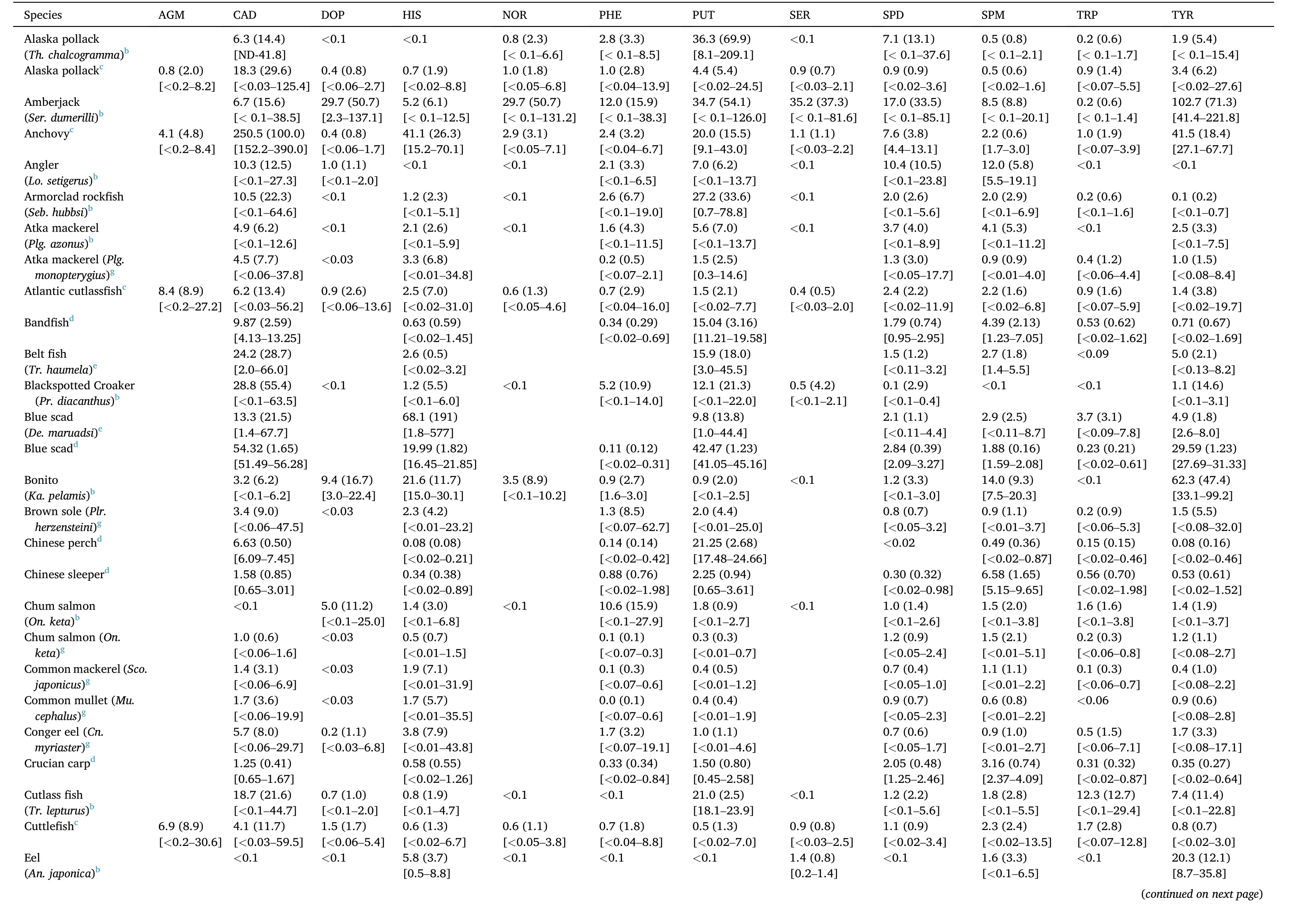
Table 1 Biogenic amine content of fresh fish.
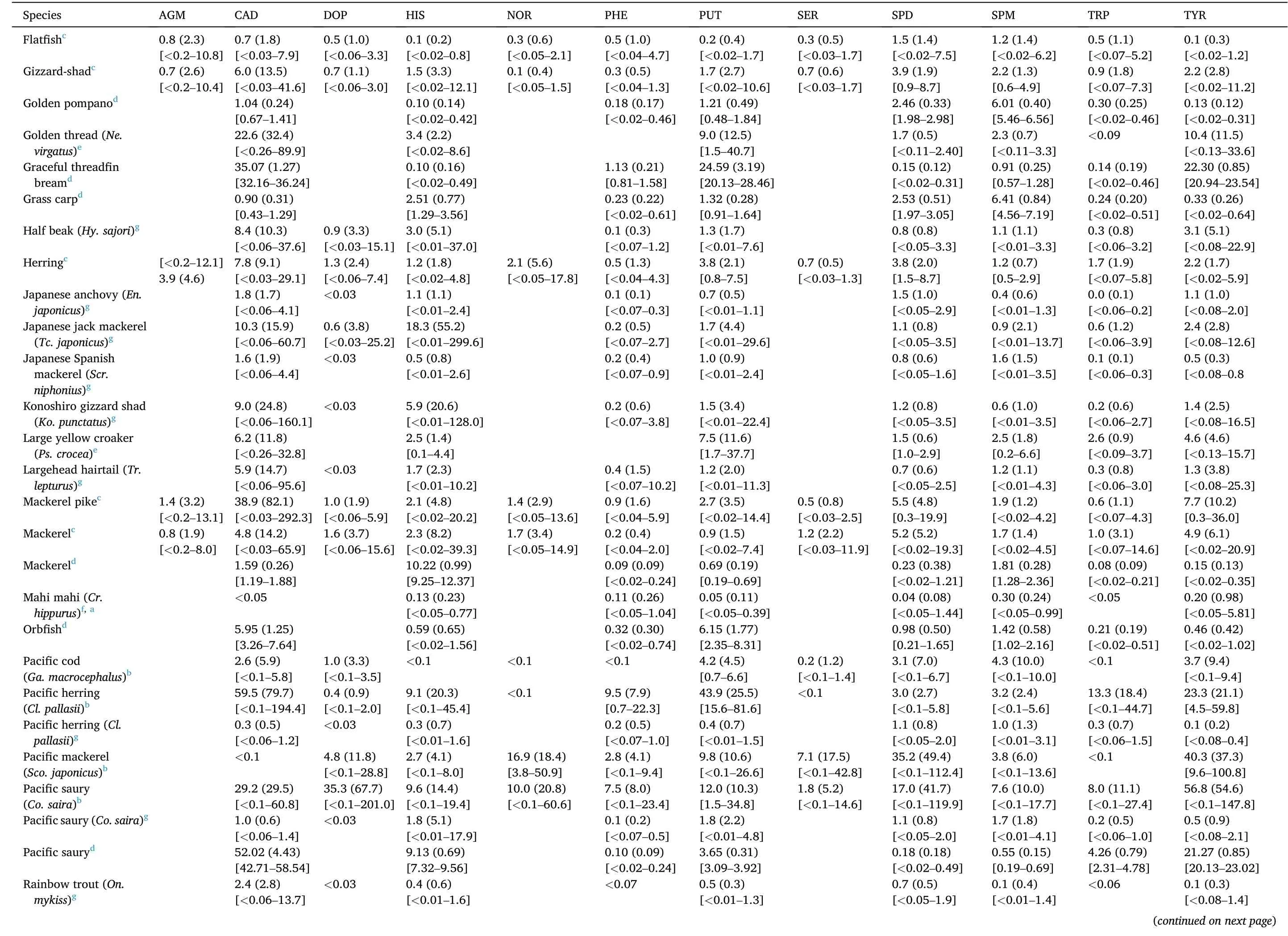
Table 1 (continued)
2.4. Effect of treatment on biogenic amine accumulation
The effect of processing on biogenic amine accumulation has drawn specific attention.The biogenic amine content of 90 fishery products,including salted, light cured, dried, salted-fermented, fermented, enzymatically matured in brine, canned and packaged ones, were retrieved from the literature and summarized in Table 3.The highest concentration of agmatine was reported in salted fish products.Similarly, he higher level of dopamine, noradrenaline and serotonin were reported in canned samples.The highest concentration of histamine, 2-pnenylethylamine, putrescine, spermidine and spermine were detected in dried products.Likewise, the highest levels of cadaverine, tryptamine and tyramine in fermented products were noticed.More accurately, the higher concentration of agmatine (13.39 mg/100 g) was reported in salted fish products samples.The level of dopamine (21.1 mg/kg) was higher in a canned mackerel pile sample.The higher concentration of noradrenaline (13.8 mg/kg) and serotonin (4.4 mg/kg) in a canned tuna sample were reported.The higher level of cadaverine (606.3 mg/kg),tryptamine (270.6 mg/kg) and tyramine (469 mg/kg) were reported in Yulu samples.The higher histamine content (544.9 mg/100 g) was reported for dried milkfish.A smooth-tailed trevally sample was reported to contain the highest content of 2-phenylethylamine (38.1 mg/100 g)and putrescine (31.8 mg/100 g).Finally, the more elevated level of spermidine (75.96 mg/100 g) and spermine (73.8 mg/100 g) were reported for a dried bullet mackerel and a dried round scad sample,respectively.
Regarding the mean values reported, the highest ones for agmatine(0.66 mg/100 g) and dopamine (348.1 mg/kg) were reported for salted fish product and Yulu, respectively.Salted mackerel were found to contain the highest mean value of noradrenaline (2.5 mg/kg) and serotonin (1.5 mg/kg), Yulu was reported to contain the maximum amount of cadaverine (348.1 mg/kg) and tryptamine (31.4 mg/kg),dried milkfish of histamine (409.7 mg/100 g), light cured horse mackerel of 2-phenylethylamine (57.61 mg/kg), and dry salted fermented mackerel of putrescine (229.75 mg/kg) and tyramine (734.33 mg/kg).Finally, the highest mean values of spermidine (25.62 mg/100 g) and spermine (25.89 mg/100 g) were reported for dried bullet mackerel and dried blue-spotted stingray, respectively.
Several authors have assessed the effect of single processing steps on biogenic amine accumulation.Therefore, the effect of filleting, mincing,curing, use of antimicrobial compounds, pressurization, drying, freezing and curing on the biogenic amine content has been assessed and the results are summarized in Table 4.
Krizek et al.(2002) reported that mincing ofC.carpioresulted in faster putrescine, histamine, cadaverine, spermine, spermidine, tyramine and tryptamine accumulation, compared to whole muscle most probably due to exposure of more substrate (proteins, peptides, amino acids) to enzymatic actions.Similarly, Chytiri et al.(2004) reported faster accumulation of putrescine, cadaverine, tyramine, tryptamine and 2-phenylethylamine in filletedO.mykisscompared to ungutted fish.However, the final levels of spermine, spermidine and histamine were comparable.Faster accumulation of putrescine, tyramine and tryptamine in filletedD.labrax, compared to whole and gutted samples, was also reported by Paleologos et al.(2004).However, more cadaverine was detected in whole samples.In addition, decomposition of spermine and spermidine was reported in whole and gutted samples from the initial 8.77–19.68 mg/kg to below detection limit.This was not the case in filleted samples, in which 5.95 and 4.89 mg/kg spermine and spermidine, respectively, were detected in the final day of storage.
The use of antimicrobial compounds has also been considered.Krizek et al.(2002) applied Purac (a preservative agent based on lactic acid)and extended shelf life but only from a toxicological perspective since the effect on appearance was detrimental.Katikou et al.(2006) managed to control putrescine, cadaverine, histamine, spermine and spermidine accumulation through inoculation withL.sakeistrain CECT 4808, and tyramine and tryptamine by bothL.sakeistrain CECT 4808 and the combination ofL.sakeiCECT 4808 andL.curvatusCECT 904 T.The combination of the strains also controlled 2-phenylethylamine formation.
Montiel et al.(2012) applied pressurization on cold-smoked slices ofG.morhuaL.at 400, 500 & 600 MPa for 5 and 10 min and then stored the samples at 5◦C for 60 d.Microbial growth seemed to be effectively controlled, since in the majority of the cases bacterial population remained below the respective of the untreated samples.The only biogenic amines that were detected were tryptamine and spermine.In both cases no clear trend was revealed regarding the effect of the treatment and the highest amounts at the end of storage period were for tryptamine 61.18 mg/kg and for spermine 3.51 mg/kg both obtained after 600 MPa/10 min.The combination of marination with pressurization as a means to control histamine, putrescine, cadaverine and tyramine during storage under vacuum ofC.harengusat 4◦C was examined by Ucak et al.(2019).Marination with 4% acetic acid was more effective than marination with 2% acetic acid and the more intense the pressurization the less biogenic amines were accumulated.
Drying is a very common process.Arulkumar et al.(2017) studied the effect of sun-drying ofC.dorab,C.coeruleopinnatuson biogenic amine accumulation.Although the ambient temperatures that sun-drying took place could favor biogenic amine accumulation, the amount of histamine, cadaverine, putrescine, tryptamine and spermine decreased during drying, most probably due to the presence of biogenic amine decomposing bacteria.Indeed, presence ofStaphylococcusspp.andBacillusspp., that contain strains with biogenic amine decomposing capacity (Naila et al., 2010; Zaman et al., 2011, 2014) was verified throughout drying.Histamine decomposition was also reported by Sato et al.(1994) during storage of common mackerel and by Al-Busaidi et al.(2011) during storage of longtail tuna and attributed to the presence of histamine-decomposing bacteria.
Hong et al.(2013) studied the effect of freezing on biogenic amine accumulation inA.nobilisheads.For that purpose, the fish heads were packed in polyvinyl chloride bags and placed at - 40◦C for 3 m (T1);- 40◦C for 12 h and then - 18◦C for 3 m (T2); - 18◦C for 3 m (T3).After freezing they were stored in ice for 18 d.This process had no significant effect on the accumulation of tryptamine, 2-phenylethylamine, tyramine, histamine, spermidine and putrescine.More spermine was accumulated after T2 (53.5 mg/kg) compared to T1 (35.8 mg/kg) and T3(35.2 mg/kg).On the contrary, more cadaverine was accumulated after T1 (26.1 mg/kg) and T3 (21.6 mg/kg) compared to T2 (16.69 mg/kg).Histamine levels remained below 1.4 mg/kg.
Curing with salt has been reported as an effective approach to control tyramine and putrescine accumulation inA.nobilis(Liu et al., 2017).On the contrary, more spermidine and spermine were accumulated in the salted samples and histamine accumulation was not affected (Liu et al.,2017).Similarly, Zhang et al.(2015) reported that curing ofC.carpiowith salt seemed to control putrescine and cadaverine accumulation.However, curing with salt and sugar had no effect on 2-phenylethylamine, spermidine, spermine, tryptamine and tyramine accumulation and allowed the increase of cadaverine, histamine and putrescine during storage.
Environmental conditions, i.e.temperature and atmosphere composition play decisive role in biogenic amine accumulation.In general, the lower the temperature the more accumulation is delayed.This has been verified by Baixas-Nogueras et al.(2002), Krizek et al.(2002), Sil et al.(2008) and Shi et al.(2012).Bakar et al.(2010) reported that increased levels of cadaverine, 2-phenylethylamine, histamine, spermine, spermidine and tyramine accumulated during storage ofL.calcarifermuscle at 4◦C compared to the one stored at 0◦C.On the contrary, higher levels of tryptamine were detected at 0◦C as well as comparable levels of agmatine and putrescine.Similarly, Krizek et al.(2004) reported that lower storage temperature ofC.carpiofillets decreased putrescine, cadaverine, histamine, tyramine and tryptamineaccumulation but seemed to have no effect on spermine and spermidine accumulation.In addition, Li et al.(2012) reported that storage ofC.auratusfillets at 4◦C facilitated tryptamine, 2-phenylethylamine, putrescine and cadaverine accumulation compared to ice storage whereas storage conditions had no effect on histamine, tyramine, spermidine and spermine accumulation.
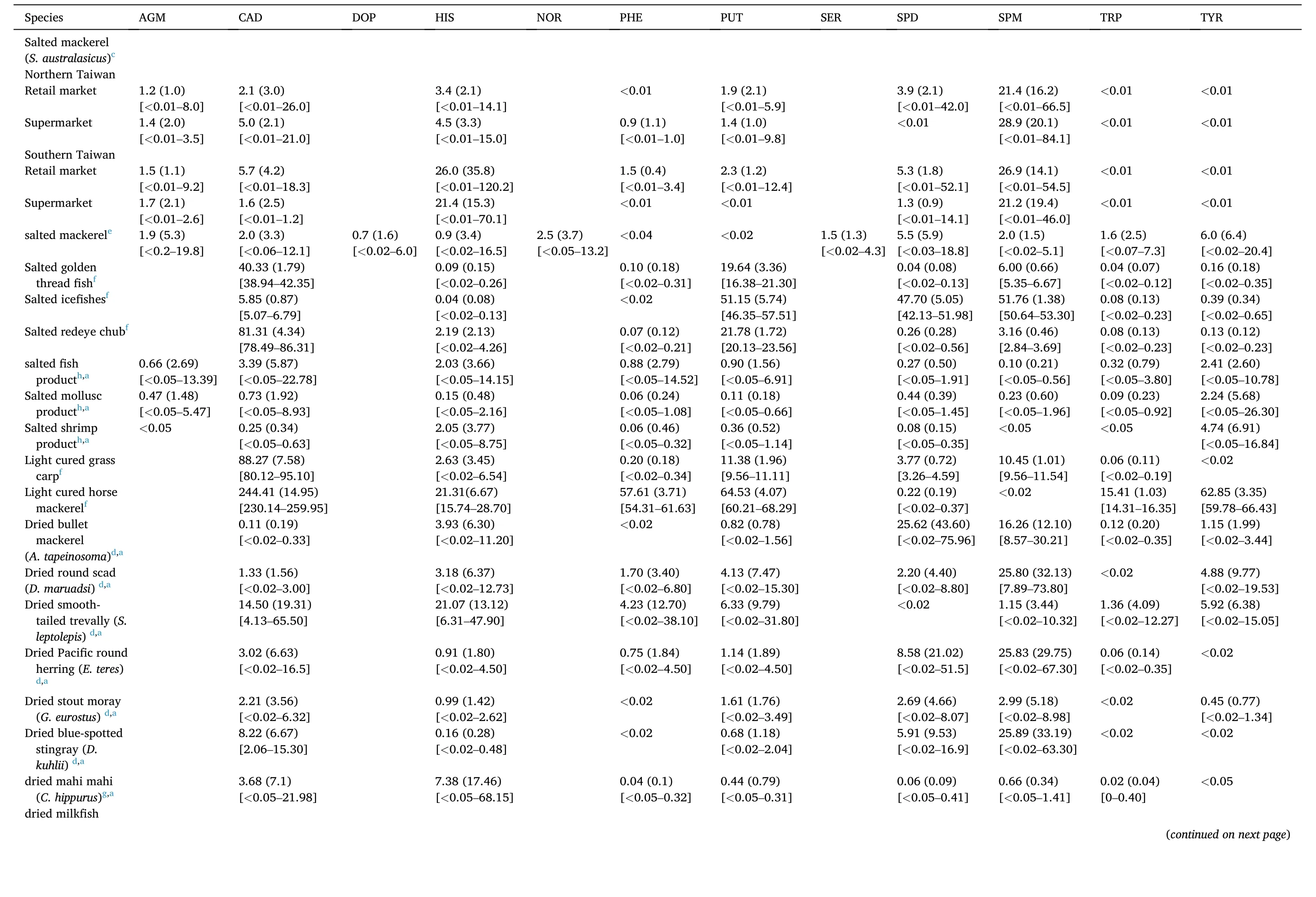
Table 3 Biogenic amine content of fishery products.
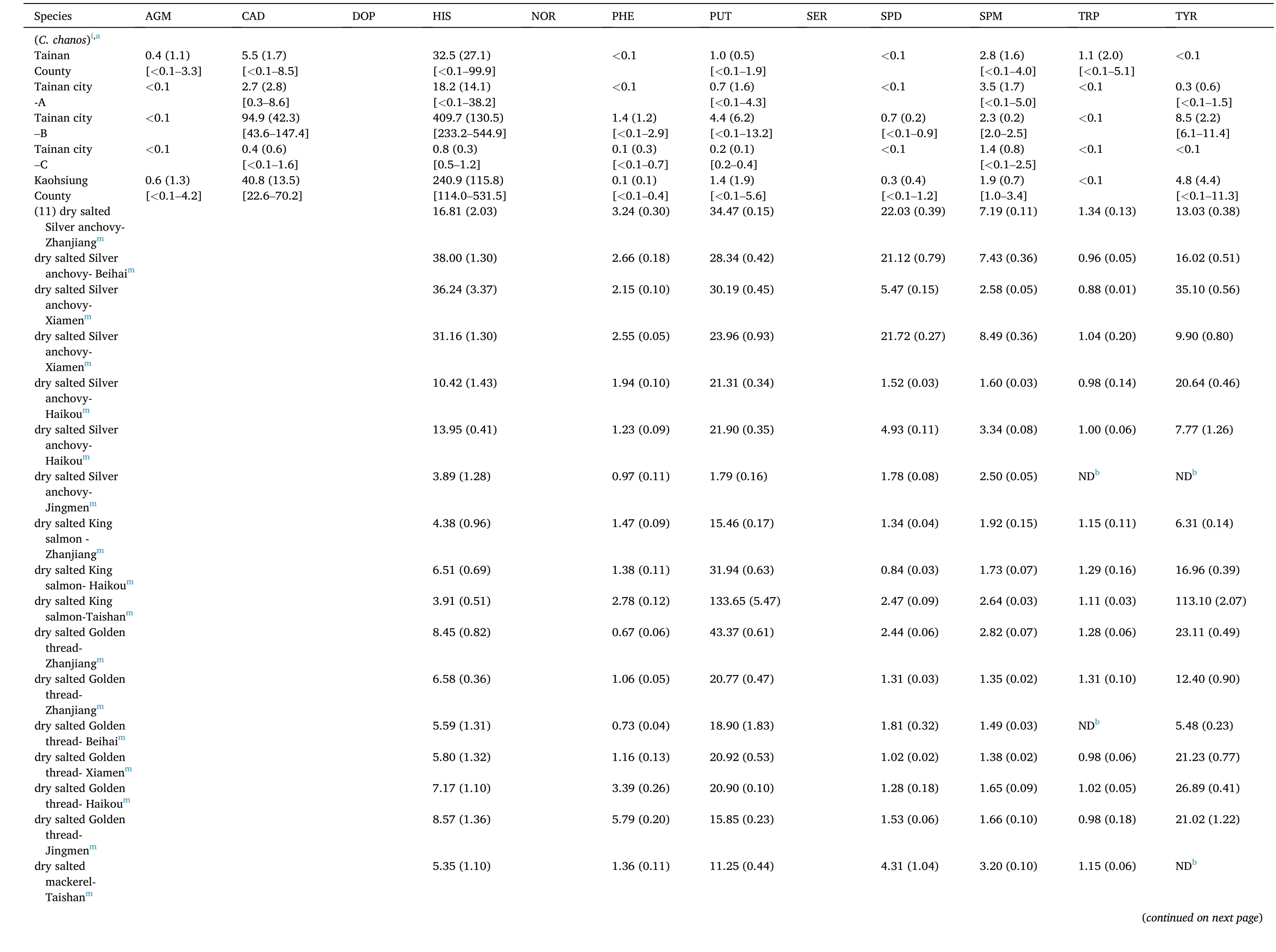
Table 3 (continued)
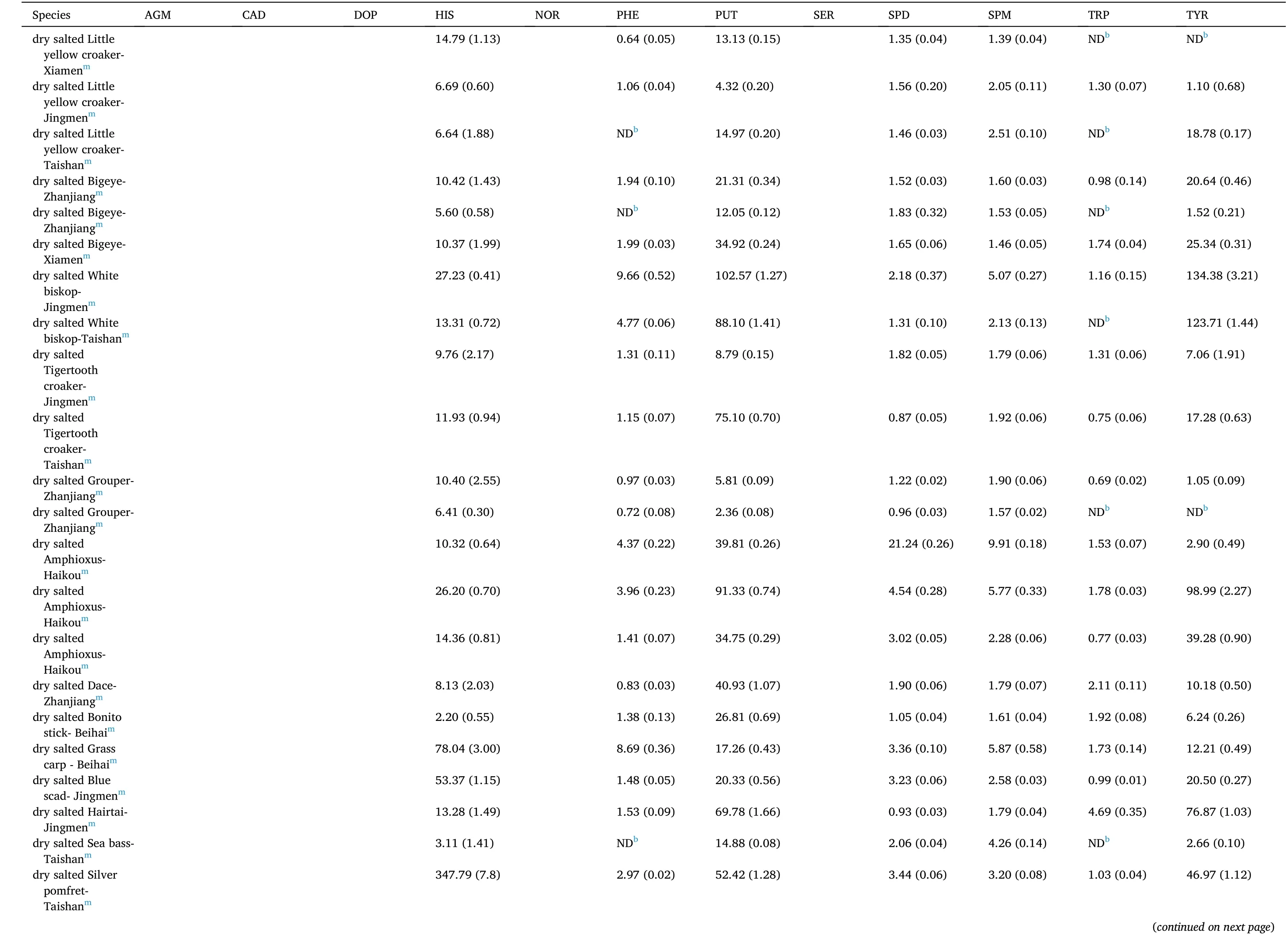
Table 3 (continued)
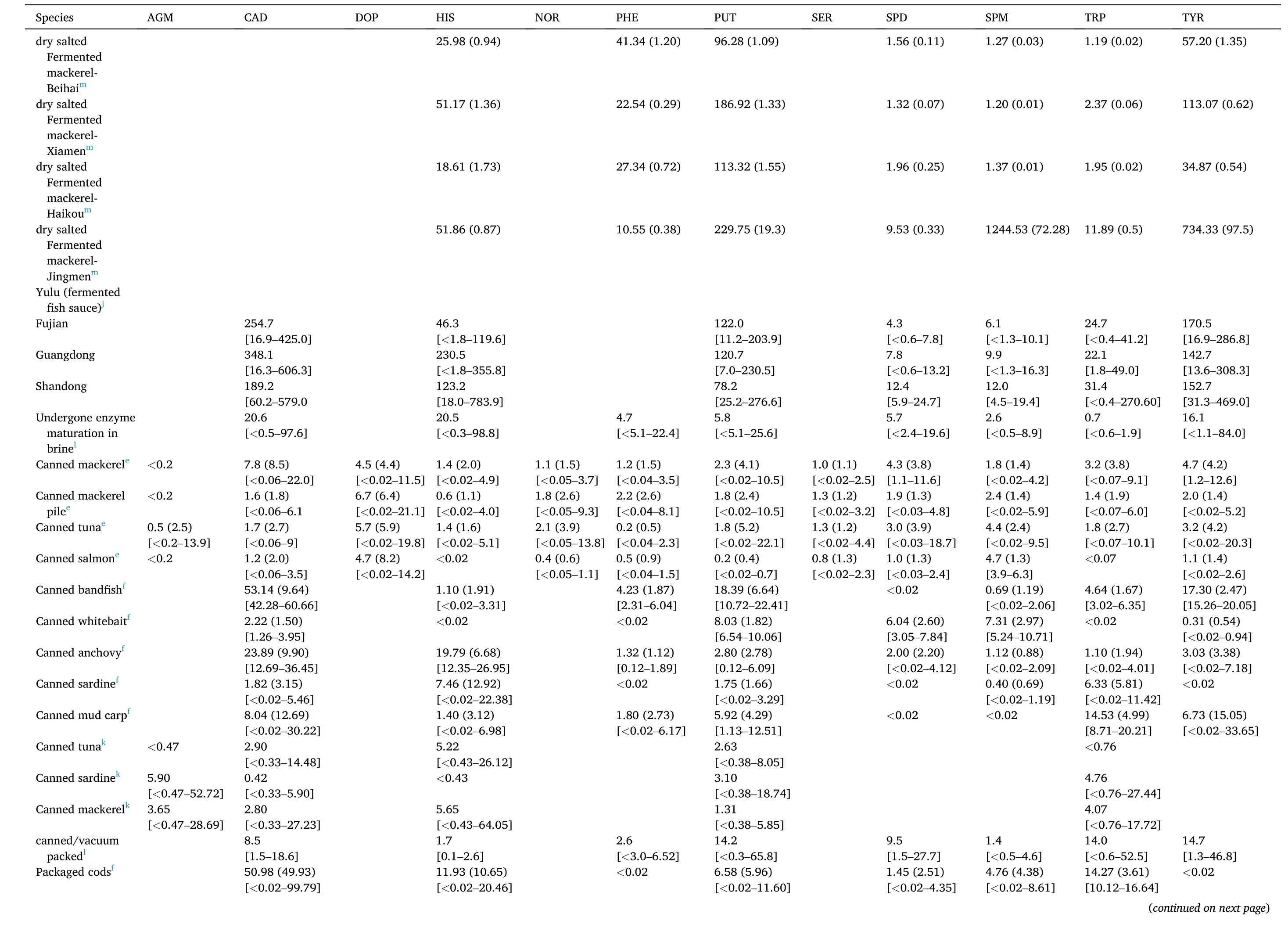
Table 3 (continued)

Table 3 (continued)
The effect of packaging atmosphere was exhibited by Yassoralipour et al.(2012).In that study, total biogenic amine and histamine accumulation during storage ofL.calcariferat 8◦C was inversely correlated to CO2concentration.However, the effect of packaging seems to be temperature dependent.Indeed, Krizek et al.(2004) reported that at 3◦C, packaging had no effect on cadaverine, spermidine, spermine,histamine and tryptamine, the amount of tyramine was higher under vacuum packaging while the amount of putrescine was higher under non-vacuum packaging.At 15◦C, vacuum packaging had no effect on putrescine, spermine, spermidine, tyramine and tryptamine accumulation, the amount of cadaverine was higher under vacuum and the amount of histamine was higher under non-vacuum conditions.Alak et al.(2011) reported that modified atmosphere packaging (100% CO2)ofS.sardafillets at 4◦C, reduced the amount of histamine compared to control and vacuum packaged fillets and no effect on putrescine,cadaverine, 2-phenylethylamine, tryptamine, tyramine, trimethylamine, spermidine and spermine.Finally, Kuley et al.(2005) reported that wrapping ofS.auratafillets with aluminum foil or cling film and storage at 2◦C for 15 d resulted in enhanced biogenic amine accumulation.Indeed, unwrapped fillets presented with lower amount of putrescine, cadaverine, spermine, 2-phenylethylamine, histamine and tyramine.
3.Current legislation and proposed limits
Several researchers have reported on the maximum tolerable biogenic amine levels in humans.More accurately, Santos (1996) stated that consumption of 1000 mg of total biogenic amines per Kg of food is dangerous for human health.In addition, ten Brink et al.(1990) reported that tyramine may be toxic if consumed at 100–800 mg/kg food.The maximum tolerable levels of tyramine were reported at 1650 mg/kg for fresh and cooked fish and at 3200 mg/kg for preserved fish (Wust et al., 2017).However, only histamine levels are currently regulated by legislation.In the European Union, 100 mg/kg has been defined as the acceptable histamine level in fishery products, with the exception of the products fromClupeidae,Coryfenidae,Engraulidae,Pomatomidae,ScombresosidaeandScombridaethat have been enzymatically matured in brine (EU, 2005).The level of 100 mg/kg is also defined by the Food Standards Australia New Zealand (FSANZ, 2016) as the decomposition indicator for all fishery products and the Food Safety and Standards Authority of India (FSSAI, 2016) as the acceptable level of all fishery products, except fermented and pickled ones.On the contrary, the United States Food and Drug Administration has defined a stricter level 50 mg/kg (FDA, 2019).
Keeping in mind the legal limits mentioned above, all crustaceans,cephalopods and shellfish samples were below the FDA limits.On the contrary, many fresh fish and fishery products samples were found to contain more histamine than allowed.In the case of fresh fish, samples of anchovies, blue scad, Japanese jack mackerel and Konoshiro gizzard shad, were reported to contain histamine beyond the FDA limits and most of them beyond the EU limits as well.Notably, the mean histamine level of blue scad samples analyzed by Hu et al.(2012) was above the FDA limit but below the EU one.In the case of fishery products, histamine levels above the FDA limits were reported for samples belonging to 11 types of products, namely salted mackerel, salted fish, salted shrimp,dried milkfish, dried bullet mackerel, dried round scad, dried smooth-tailed trevally, dried mahi mahi, Yulu, canned mackerel and fish product undergone enzyme maturation in brine.The EU limits were not exceeded only by salted shrimp product, canned mackerel and fish product undergone enzyme maturation in brine.In addition, the meanhistamine value of seven types of products, namely dried smooth-tailed trevally, dried mahi mahi, dried milkfish, Yulu, dry salted fermented mackerel, dry salted grass carp and dry salted blue scad were reported above the FDA limits.In the latter case, the EU limits were exceeded only by dried smooth-tailed trevally, dried milkfish and Yulu.
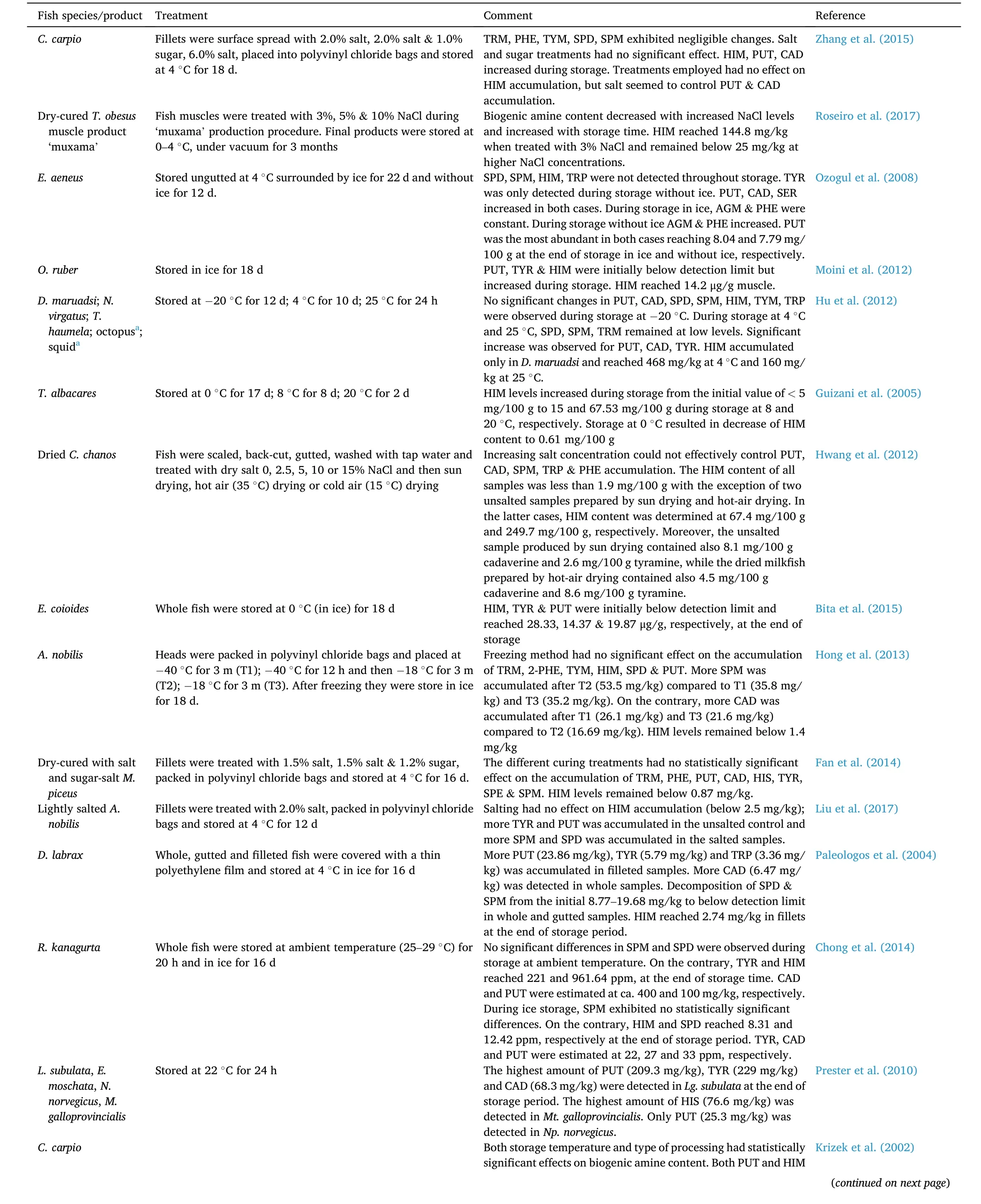
Table 4 Effect of treatment in the accumulation of biogenic amines in fish and fish products.
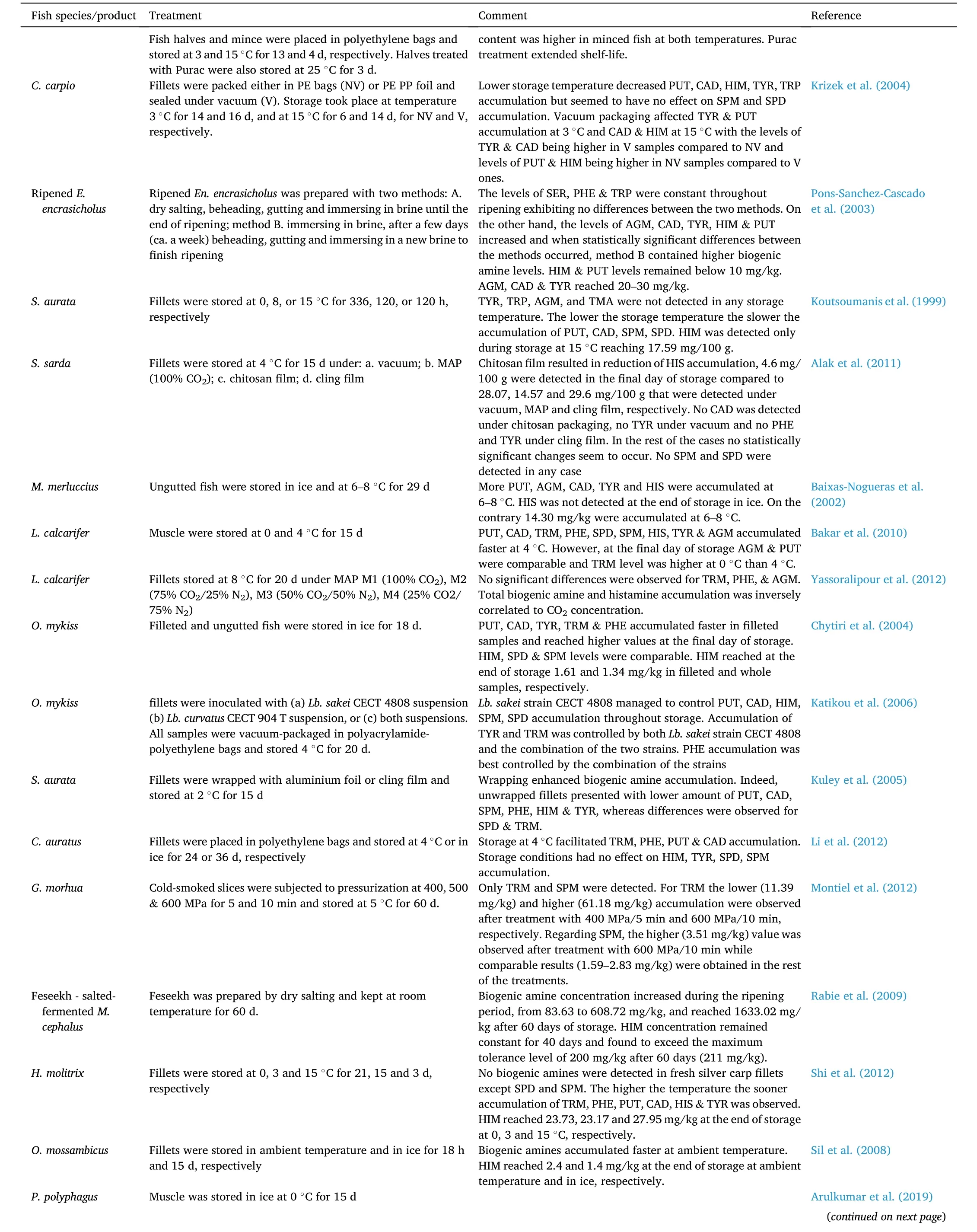
Table 4 (continued)

Table 4 (continued)
Regarding the limits that have been proposed but are yet to be regulated by legislation, dry salted fermented mackerel was reported to contain more than 1000 mg/kg total biogenic amines.Concerning tyramine, the mean values of fresh fish, crustaceans, cephalopods and shellfish did not exceed the limit of 100 mg/kg.However, some samples of pacific mackerel and pacific saury were reported above this limit.Similarly, some dried round scad, dried smooth-tailed trevally salted fish product, salted mollusc product, salted shrimp product and Yulu were found to contain more than 100 mg/kg tyramine.As far as the mean values were concerned, Yulu, dry salted king salmon, dry salted fermented mackerel and dry salted white biskop were also reported to contain more tyramine.The tryptamine levels in all samples were below the limits set by Wust et al.(2017).
4.Emerging control strategies
The need for effective control of biogenic amine accumulation has already been highlighted.Currently, two strategies seem to be in the epicenter of research interest, namely the use of natural products,essential oils or various extracts, and the use of nanotechnology.
The use of essential oils or extracts of a wide variety of plant materials for food preservation has been extensively considered (Chibane et al., 2019; Ju et al., 2019).This is also the case of fish and fishery products.The effect of such products in fish preservation, mostly in combination with other preservation means, such as icing, packaging in MAP, vacuum, application of chitosan coatings and oxygen absorbers has been assessed and recently reviewed by Baptista et al.(2020).Their effectiveness has been documented through assessing the fate of microbial populations, or quality indicators such as lipid oxidation, total volatile basic nitrogen, trimethylamine nitrogen peroxide value, thiobarbituric acid value, color changes and organoleptic acceptance.However, only a few studies have assessed the effect on biogenic amine formation.The results obtained have revealed that the effect depends upon the type of plant and extract applied, the additional preservation measures employed, the type of fish and time.Collectively, no particular trend regarding the effectiveness in controlling the accumulation of biogenic amines was evident, highlighting, thus, the need for further study.More accurately, Ozyurt et al.(2011) studied the combined effect of icing and water soluble rosemary (Rosmarinus officinalis) extract on biogenic amine accumulation during storage of wholeSardinella auritaat 4◦C for 15 d.At the end of storage period, application of this extract resulted in a decrease in agmatine, histamine, putrescine and spermidine and no effect on spermine formation.Interestingly, it also resulted in the increase of cadaverine, 2-phenylethylamine and serotonin formation.Treatment with 0.5% rosemary extract resulted in the decrease of dopamine but treatment with 1.0% had no effect.In addition, tryptamine and tyramine were only detected after treatment with 1.0% rosemary extract.Ozogul et al.(2011) studied the effect of the ethanolic extract of rosemary and sage tea (Salvia officinalis) on the biogenic amine formation during storage of vacuum packedSardina pilchardusfillets at 3◦C for 20 d.At the end of the storage period, both extracts managed to control cadaverine, dopamine, 2-phenylethylamine, putrescine, serotonin, trimethylamine and spermine, accumulation.Furthermore, sage tea was effective against spermidine and tyramine formation and rosemary against histamine.The amount of tryptamine formed was higher after sage treatment.Similarly, the amount of agmatine accumulated was higher after application of the extracts with rosemary resulting in more agmatine formation compared to sage.Cai et al.(2015) studied the effect of clove, cumin and spearmint essential oils on biogenic amine formation during storage ofSciaenops ocellatusin polypropylene container at 4◦C for 20 d.All essential oils effectively controlled histamine, putrescine and cadaverine and had no effect on spermine, spermidine and tryptamine accumulation.Tyramine was effectively controlled by cumin and spearmint essential oils but an increase in the amount produced was observed after treatment with clove.The effect of mint (Mentha spicata) and artemisia (Artemisia campestris) ethanolic extracts on the accumulation of biogenic amines during storage ofSardina pilchardusfillets at 3◦C for 21 d was studied by Huicher et al.(2015).Mint extract was more effective than artemisia extract in controlling serotonin, cadaverine, spermidine, tryptamine,putrescine, dopamine and histamine accumulation.On the contrary,artemisia was more effective than mint in controlling tyramine formation.Both extracts had no effect on agmatine and mint extract had no effect on spermine formation.2-phenylethylamine was detected only after treatment with the extracts.Finally, artemisia treatment resulted in the increase of putrescine, dopamine and spermine.Noori et al.(2018)reported thatCarum copticumessential oil effectively controlled cadaverine, histamine and tyramine accumulation during storage ofC.carpiofillets packed in polyethylene containers at 4◦C for 18 d.However,treatment with 1.5% lactic acid was more effective.More recently, Wang et al.(2019) reported on the effectiveness of phloretin, a naturally occurring flavonoid, to control histamine, cadaverine, putrescine and tyramine accumulation during storage of Atlantic salmon at 4◦C.
Nanotechnology has invaded food science and technology, particularly in the fields of processing and packaging, providing with an alternative approach to address modern challenges.Although the sustainability question of this approach has been recently raised (Das et al.,2019), it is still considered as an emerging and quite promising development.This is also the case of fish and fishery products.Several studies are currently available on the utilization of such applications in seafood preservation.These studies have been recently collected and critically reviewed by Dar et al.(2020).Unfortunately, no studies are currently available on the fate of biogenic amines.
5.Conclusions
Occurrence of biogenic amines in fish and fishery products has been principally assigned to improper handling procedures after catch and the concomitant growth of microorganisms possessing amino acid decarboxylases, mostly Gram-negative bacteria.Although biogenic amines possess important role in fish physiology, the effect of growth and catch conditions has not been assessed from that perspective.Control of biogenic amine formation through suppression of the developing microcommunity has been extensively considered by both traditional procedures, such as salting, drying and fermentation, and modern strategies, such as modified atmosphere packaging, pressurization and application of natural antimicrobial compounds.In all cases, no clear trend has been revealed, indicating the complexity of the microecosystem that develops after catch and highlighting the necessity for further research.
CRediT authorship contribution statement
Abimannan Arulkumar:Investigation, Visualization, Conceptualization, Writing - review & editing.Spiros Paramithiotis:Investigation,Formal analysis, Writing - review & editing.Sadayan Paramasivam:Investigation, Formal analysis, Writing - review & editing.
Declaration of competing interest
The authors declare that they have no known competing financial interests or personal relationships that could have appeared to influence the work reported in this paper.
Acknowledgements
One of the authors (A.A), gratefully acknowledges Department of Science and Technology (DST)-Science and Engineering Research Board(SERB) New Delhi, for the fellowship Grant (SR/FT/LS-22/2010), S.P acknowledges RUSA–2.0 [F.24–51/2014–U, Policy (TNMulti– Gen),Department of Education, Government of India] for the infrastructure facilities.
杂志排行
Aquaculture and Fisheries的其它文章
- A framework for risk analysis of the shellfish aquaculture: The case of the Mediterranean mussel farming in Greece
- Slurry ice as an alternative cooling medium for fish harvesting and transportation: Study of the effect on seabass flesh quality and shelf life
- Application of hurdle technology for the shelf life extension of European eel(Anguilla anguilla) fillets
- Physicochemical properties of silver carp (Hypophthalmichthys molitrix)mince sausages as influenced by washing and frozen storage
- Bacterial community in response to packaging conditions in farmed gilthead seabream
- Effective algorithmic operational framework for fish texture evaluation in industry: Achieving maturity
